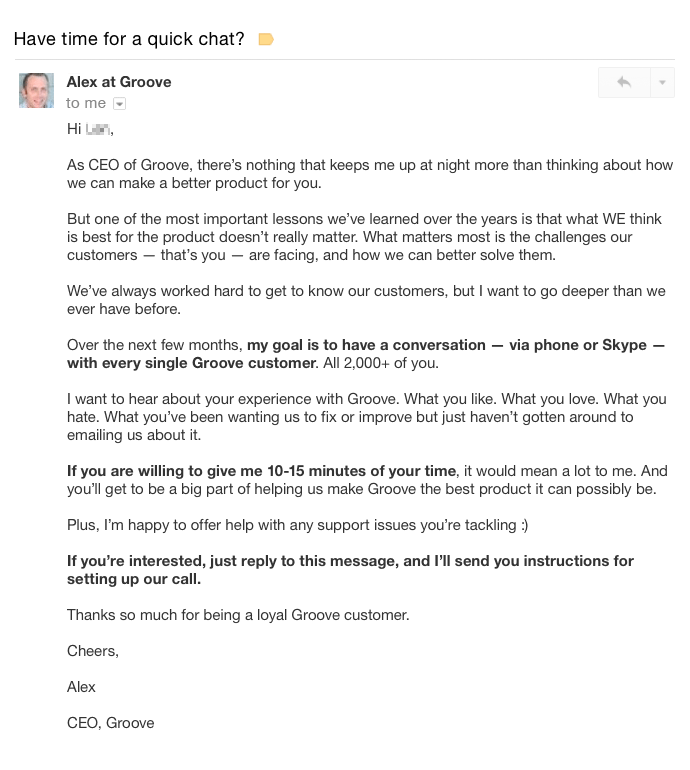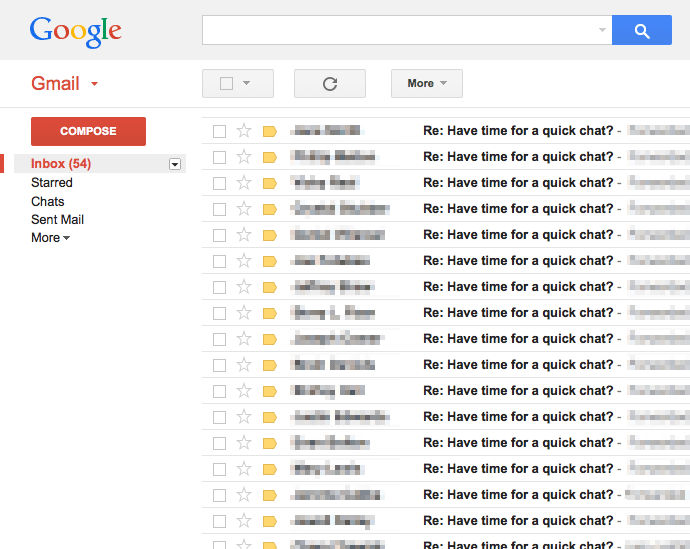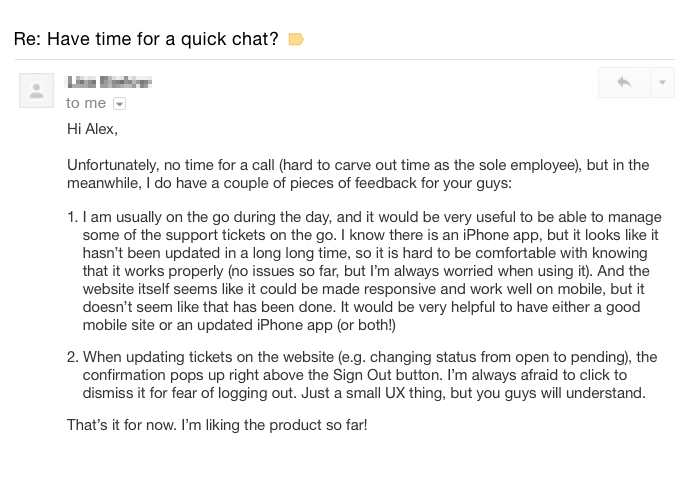Customer Development for startups or what can be understood from a conversation with 500 clients
- Transfer

Remember how the military commanders had a “red” phone? In an extreme case, when the situation gets out of control and there is nothing left to do but order: “connect me with the commander in chief!”
Something similar exists for the founders of startups, when the main indicators for revenue and conversions are at variance with your plans like ships in the sea. What to do, where to run, what to grab? You can "drill" into metrics, analyze the places of "leakage throughout the funnel", from leads to regular customers. You can consult with experts, test headings, lead form, buttons and other conversion elements on the site.
And you can grab the "red" phone. Only instead of the president are your clients. That's what Groove SaaS founder Alex Turnbull did. To optimize the product, he decided to just talk with customers of the service. Because no analytics with tons of numbers will help to understand the user experience better than users themselves will tell about it.
Alex spent more than 100 hours communicating with subscribers. And this is what he learned.
500 conversations with customers in 4 weeks
First, Alex sent each Groove user a letter:

He begins with customer care: “Thoughts on how to improve the product for you keep me awake at night.”
Problem: "Developer ideas often do not match what users really need."
Proposal: “In the next few months, my goal is to talk to each of more than 2,000 Groove customers over the phone or skype, including with you. I want to hear about your experience with the service: what you like and what you hate; what you would like to see in the service, but do not dare to write about it.
If you give me 10-15 minutes of your time, this will help us make Groove the best solution as possible. ”
The response to the letter is crazy. According to Alex, he expected a couple of hundreds of subscribers to reply, but his mail “exploded” from messages:

What was done:
To fix the results - a template in Google Docs ( you can adapt and use it) Supporting tools - Doodle (event planner), phone, skype, pen and paper.
Alex personally spent more than 100 hours of skype sessions in 4 weeks, because Customer Development is "the same prerogative of the startup founder as a development strategy or meeting with investors."
Why is live communication chosen? Compared to reading responses by e-mail, this allows you to “feel the customers and get a clearer understanding of what and how to complete the product.”
And the use of standard options in online surveys makes customers respond within strictly specified frames. They only say what you ask. As a result, some of the problems (developers may not even be aware of their existence) remain “overboard”.
What it brought: 7 insights for a startup
The main “victory” is an understanding of how users perceive and use the product in reality, what specific problems are solved with its help. For Groove, the results of 100-hour Skype calls by Alex Turnbull became the roadmap for subsequent decisions in terms of service and functionality.
Here are all 7 insights:
1) Improvement of onboarding (user support at the beginning of work with the product)
Many Groove clients complained about problems related to the lack of certain functionality (for example, integration with CRM). While these features are already in the service. User reaction: “Wow, but I didn’t know!” This is a sign that you need to improve the training program for new subscribers. Users should be aware of all the chips and benefits of the service.
The solution is onboarding (a series of letters demonstrating how the main features work and what this gives the user) + a manual built into the application.
2) Restoring relations with dissatisfied customers
Each service has users who have not figured out something, have not received help from technical support, or complain about the insufficient functionality in their opinion.
Here it is necessary to deal with the true cause of discontent. One thing is the lack of information. As a solution, we show how this or that feature works.
It is much more difficult to remove annoyance from unfulfilled expectations. In no case do not try to prove to the user that his “Wishlist” is a trifle. Or that the unfinished part of the product works as it should.
Find out why it is important for him, what tasks he needs to solve. Listen carefully to the client, share your plans in the spirit of “Gathering wishes, in the near future we will realize this and that, but for now you can use these tools to solve your problem.” Simple human participation already eliminates the lion's share of irritation.
3) Expanding the target audience
Of course, Groove had an idea of who they were working for. At the same time, as the company grows, this view may diverge from reality - new users come with new needs. For example, Alex was surprised to learn about schools that use the service to provide information support to students. This greatly expanded his view of the potential sales market. Product developers may not even suspect that someone outside their “world view” is looking for a similar solution.
4) Increasing user loyalty
Even the loyal fans of the service were pleasantly surprised by the offer of Alex Turnbull, not to mention the “heavy customers”. No one has ever been so interested in their opinions. 99.9% of positive reactions + many from the “risk zone” changed their anger to mercy and extended their subscription. Loyalty = profit. Note - with minimal funds.
5) Quick solution to minor problems with functionality
Small bugs in the product can greatly undermine the trust of users (compatibility of the service with certain domains, for example). Usually they are silent about them, but they interfere like a speck in the eye. Feedback allowed developers to quickly fix them. Alex calls it Customer WOW:

“It was so fast :) Thanks, Alex, your guys are awesome!”
6) Improving the effectiveness of content on the site
Groove marketers have not just gathered feedback. They used customer expressions to describe the benefits of the service on the new site. The result is a 2-fold increase in conversion (!). Read more in the previous article .
7) Comprehensive feedback Feedback was
given by those who could not communicate on Skype. They just answered the email. For example, a wish to finalize the mobile version:

How to apply user feedback for product development
First, Alex grouped feedback on the type of problem (functionality, support, pricing, etc.) and the frequency of mention. This helped to qualify all tasks as "burning", important and less important. What is urgently needed to “finish” what can wait, and where is enough to explain how to use one or another feature.
Secondly, we adjusted the marketing plan for the new CA groups, which we had no idea about before. How to work with them + ideas to whom else the product may be useful.
Yes, Groove now offers a 10-minute Skype call to each new user (in the welcome letter). Early results say that it prevents a bunch of potential problems and questions. Well, and greatly increases the loyalty of subscribers, of course. Because no one does it and ... customers "cheer" perceive it when they treat them like people, not "wallets".
According to the founder of Groove, this venture has greatly changed the product and thinking of the team. “It’s not necessary to talk with absolutely every client. Chat with at least a small part. It will change your business. ”
Comment of the founder of Yagla.ruAlexandra Alimova
As you can see, Customer Development does not always follow the ideal scenario. Already in the process of work, 100% unforeseen phakaps will pop up both in the product and in the user experience. It is not scary if you see and correct them in time. We are looking at the Groove experience, to what extent it can be adapted to our realities. It is believed that in RuNet this approach will not work.
Share in the comments what you think about it.
